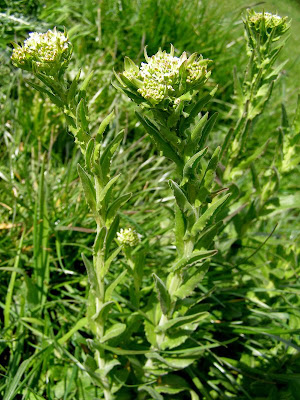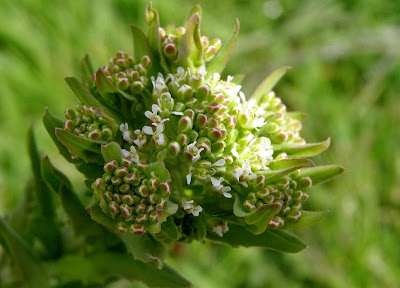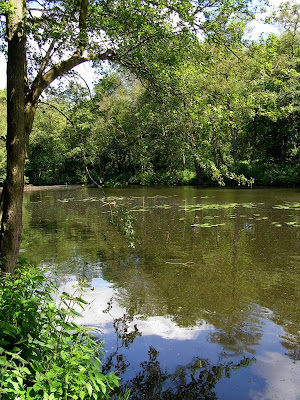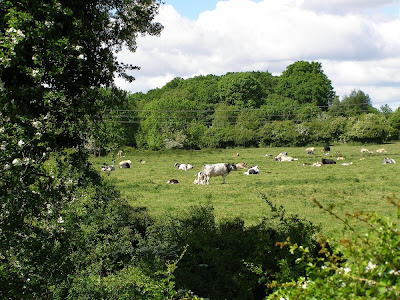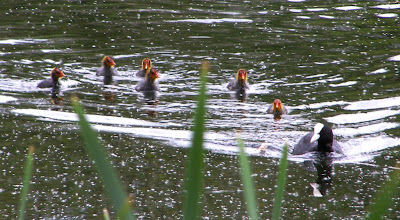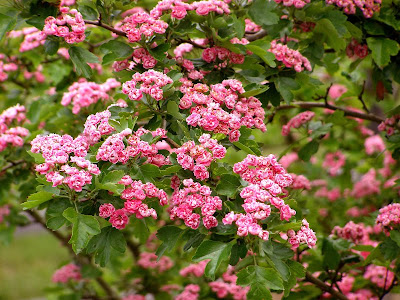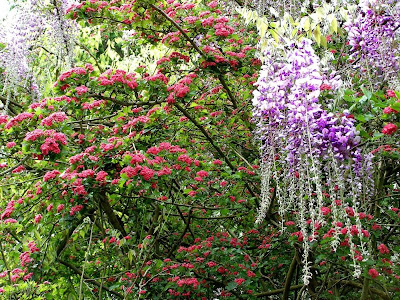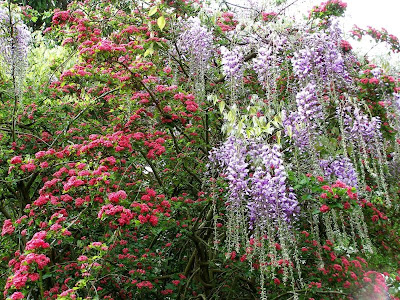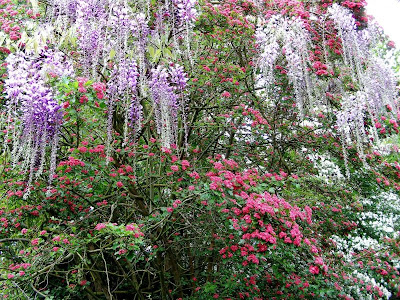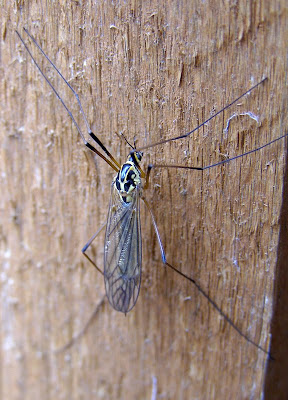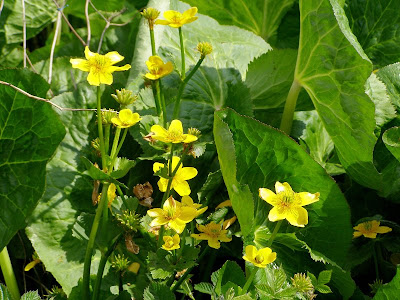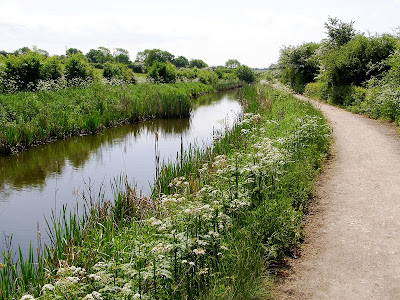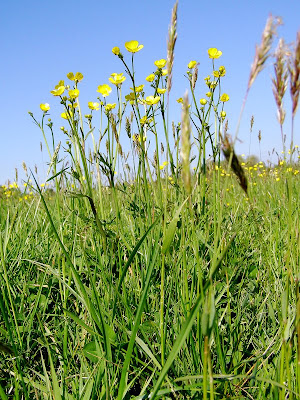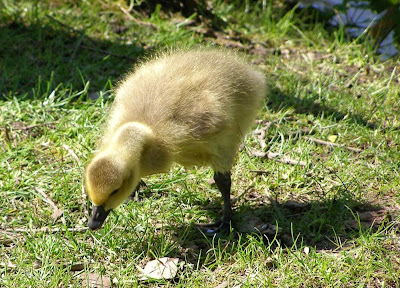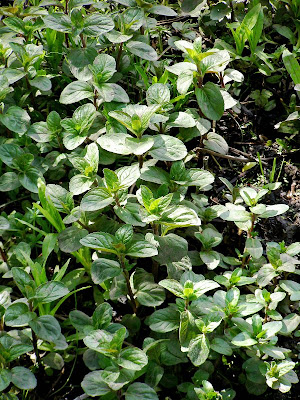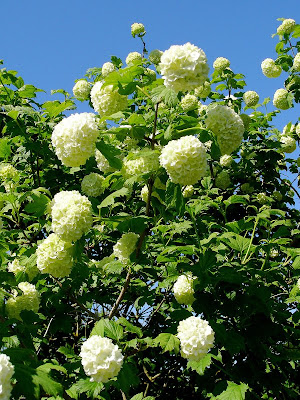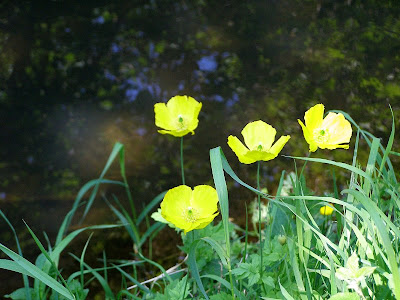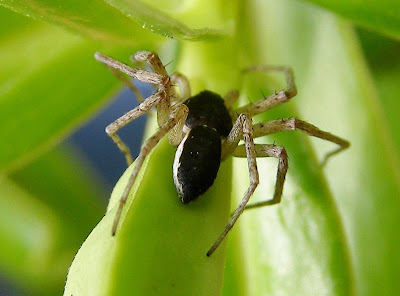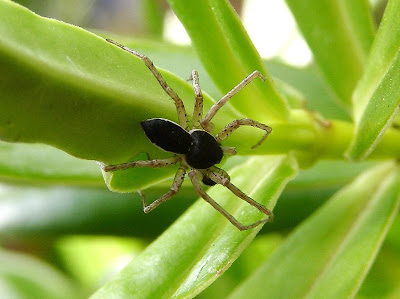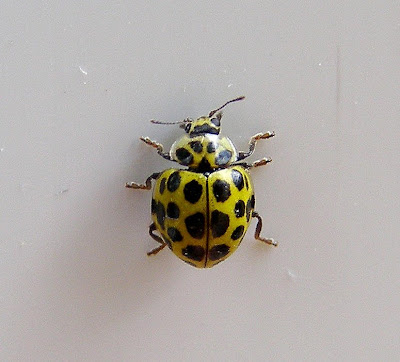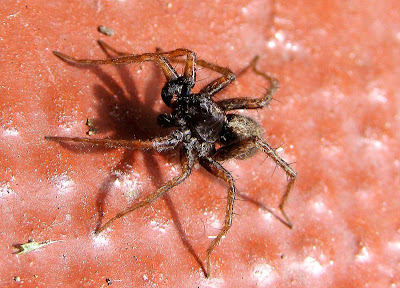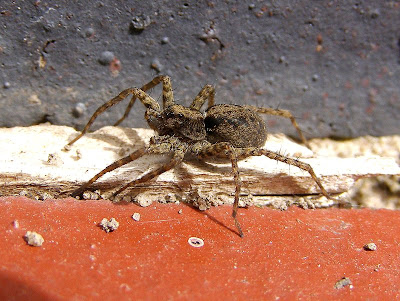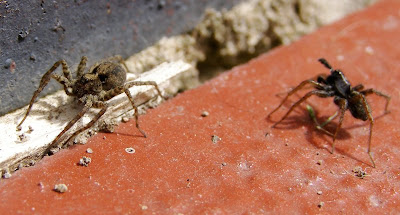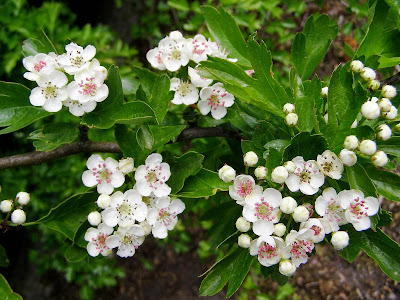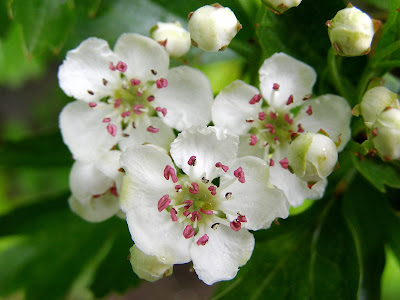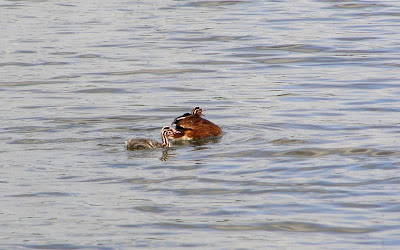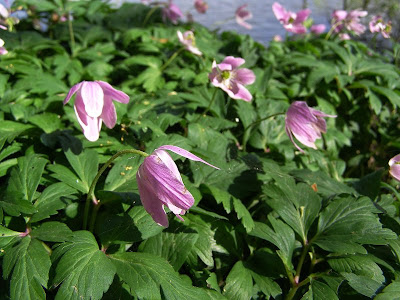A short post today as we've not had a walk in the country this morning. It's always a bit too busy at weekends and bank holidays - which doesn't do much for my misanthropic tendencies - so it was off to Farmfoods for a little shopping instead.
Just an update to the problem of the un-named brassica from last Wednesday. I am now almost 100% certain it is a Hoary Whitlowgrass (Draba incana).
Culpepper has this plant as a useful addition to the medieval medicine cabinet, saying "...A strong infusion of the whole plant, fresh gathered, is an excellent sweetener of the blood and juices, and good against scorbutic complaints in general... This plant is accounted a specific against the king's evel" (otherwise known as Tuberculous cervical lymphadenitis - a result of an infection in the lymph nodes).
Lastly for today, another plant with tiny flowers and a member of the Knotweed family, the Common Sorrel (Rumex acetosa).
This too, is a very useful medicinal plant in Culpepper's Herbal. He says of this plant "...It is prevalent in all hot diseases, to cool any inflammation and heat of blood in agues, pestilential or choleric, or sickness and fainting, arising from heat, and to refresh the overspent spirits with the violence of furious or fiery fits of agues; to quench thirst, and procure an appetite in fainting or decaying stomachs.... The leaves wrapt in a colewort leaf and roasted in the embers, and applied to a hard imposthume, botch, boil, or plague sore, doth both ripen and break it."
Welcome to my blog. Don't expect anything too high-tech or flashy, this is simply a 'diary' to share some of my photos, thoughts and observations - with a particular bias towards the natural world and the countryside around my home.
Monday 31 May 2010
Sunday 30 May 2010
Youngsters
Nice to get out for a walk this morning after a couple of days without. But, my goodness it was windy! The Hawthorn blossom was being torn from the trees in such vats numbers, that it seemed like we were emerging from a church after a very posh wedding. We were almost knee-deep in petaled confetti as we walked along the Nutbrook Trail.
Approaching the lake known as the Beauty Spot, the sun shone on the water and the lily pads, and the wind tried to blow the leaves off the trees.
Young calves were laying around in the sun alongside their mothers, chewing the cud and looking vacantly into the distance, taking no notice of us as we passed.
More youngsters were to be seen on the lakes, this time it was the Coot families which were providing infinite entertainment as they clamoured for food from their fraught-looking parents.
It is good to see the blossom on the Hawthorn tree at the front of our house, has not been ripped from the stems and is still looking pink and lovely in it's double-flowered exquisiteness.
Approaching the lake known as the Beauty Spot, the sun shone on the water and the lily pads, and the wind tried to blow the leaves off the trees.
Young calves were laying around in the sun alongside their mothers, chewing the cud and looking vacantly into the distance, taking no notice of us as we passed.
More youngsters were to be seen on the lakes, this time it was the Coot families which were providing infinite entertainment as they clamoured for food from their fraught-looking parents.
It is good to see the blossom on the Hawthorn tree at the front of our house, has not been ripped from the stems and is still looking pink and lovely in it's double-flowered exquisiteness.
Thursday 27 May 2010
Wisteria
A chilly wind blew through us this morning as we walked through the parkland. Around the lakes of Straw's Bridge to check on the swan, still sitting on her nest. A sad sight followed however, as there was a dead swan laying beside one of the lakes. There has been a dead swan floating among the reeds of another of the lakes, for a week or more, and this second death starts to look a little worrying. We have sometimes seen 'bits' of dead swans among the undergrowth which are probably the result of fox attacks, but these are different inasmuch as there don't appear to be any marks on the bodies. We'll see what happens next.
Better news as the Great Reed Warbler is still singing his heart out on the lake where the swan is incubating her eggs. Then as we came away from the lakes, we passed a red-flowered Hawthorn tree growing beside a private garden which is shot through with the stems of a beautiful Wisteria (Wisteria sinensis).
Wisteria is another member of the pea family and is well-known to gardeners everywhere. This one seems particularly showy as it's violet blooms intermingle with the red of the Hawthorn.
Native to East Asia, Wisteria is a very hardy and strong grower. In fact, the largest Wisteria vine known, is supposed to cover an area of more than an acre and is estimated to weigh over 250 tons. This one is much smaller, but no less beautiful.
Better news as the Great Reed Warbler is still singing his heart out on the lake where the swan is incubating her eggs. Then as we came away from the lakes, we passed a red-flowered Hawthorn tree growing beside a private garden which is shot through with the stems of a beautiful Wisteria (Wisteria sinensis).
Wisteria is another member of the pea family and is well-known to gardeners everywhere. This one seems particularly showy as it's violet blooms intermingle with the red of the Hawthorn.
Native to East Asia, Wisteria is a very hardy and strong grower. In fact, the largest Wisteria vine known, is supposed to cover an area of more than an acre and is estimated to weigh over 250 tons. This one is much smaller, but no less beautiful.
Wednesday 26 May 2010
Insect
On Monday, when we returned from our walk, I discovered a rather fascinating insect on the garden fence, soaking up the sun. Obviously a Crane fly or Daddy-long-legs, it had a striking, black and yellow pattern on it's thorax.
It is, in fact, a Spotted Crane fly (Nephrotoma appendiculata). With a 2 inch wingspan, it is a fairly large member of the Crane fly family and is distributed almost all over Europe and fairly common. But, it was a new one on me.
Back to the plants - and the Great Burdocks (Arctium lappa) are starting to grow to their full size along the pathways of Shipley Park. The leaves are huge in comparison to those of it's neighbouring plant species. At about 2ft long by 1ft wide, they make an imposing sight, even before the rest of the plant starts to head sky-ward.
A couple of weeks ago, I noticed a plant which stumped me. It was just beginning to show a flower head and from that it was clear that it was a member of the Cabbage or Crucifer family, but that was as far as I got in identifying it. Now, it has grown a lot more and the flowers have started open further, it has been possible to identify it as a Whitlowgrass but which one, is still up for debate. I'll get back to you when I have made a positive ID.
It is, in fact, a Spotted Crane fly (Nephrotoma appendiculata). With a 2 inch wingspan, it is a fairly large member of the Crane fly family and is distributed almost all over Europe and fairly common. But, it was a new one on me.
Back to the plants - and the Great Burdocks (Arctium lappa) are starting to grow to their full size along the pathways of Shipley Park. The leaves are huge in comparison to those of it's neighbouring plant species. At about 2ft long by 1ft wide, they make an imposing sight, even before the rest of the plant starts to head sky-ward.
A couple of weeks ago, I noticed a plant which stumped me. It was just beginning to show a flower head and from that it was clear that it was a member of the Cabbage or Crucifer family, but that was as far as I got in identifying it. Now, it has grown a lot more and the flowers have started open further, it has been possible to identify it as a Whitlowgrass but which one, is still up for debate. I'll get back to you when I have made a positive ID.
Tuesday 25 May 2010
Peas and Goats
A cooler walk this morning around the site of the old West Hallam Colliery. The footpaths are numerous around this part of the park and you could lose yourself for hours. Many more flowers are beginning to show their true colours after the last few days of hot weather, not least of which are these members of the pea family, the Birds-foot trefoil (Lotus corniculatus).
Common throughout Europe, this is a valuable fodder plant for all grazing animals. It is a valuable plant also, for several moth and butterfly species as their caterpillars feed on the leaves. However, they contain a substance called cyanogenic glycoside and are therefore poisonous to humans - but no less beautiful for that.
As we turned for home, we walked along the edge of a meadow, next to a small stream, along which was growing a large quantity of Common Comfrey (Symphytum officinale).
Related to Borage - which you might know if you have ever had their blue flowers floating in your 'G & T' or 'Pimms', this is versatile plant, useful as a natural fertiliser and for having several medicinal uses. They were once used as a treatment for broken bones and as such, came to get the common name of 'Knitbone'.
On to the Goats that I mentioned in today's title. Not the cloven-hoofed bovid mammals known to us all, but a small, yellow flower called Goat's Beard (Tragopogon pratensis).
A member of the family which includes Dandelions, you can see the similarity in the flower. These flowers are sometimes called 'Jack-go-to-bed-at-noon' because the flowers often close around that time, or Meadow Salsify as it is related to the Salsify which you might know from your kitchen garden.
Common throughout Europe, this is a valuable fodder plant for all grazing animals. It is a valuable plant also, for several moth and butterfly species as their caterpillars feed on the leaves. However, they contain a substance called cyanogenic glycoside and are therefore poisonous to humans - but no less beautiful for that.
As we turned for home, we walked along the edge of a meadow, next to a small stream, along which was growing a large quantity of Common Comfrey (Symphytum officinale).
Related to Borage - which you might know if you have ever had their blue flowers floating in your 'G & T' or 'Pimms', this is versatile plant, useful as a natural fertiliser and for having several medicinal uses. They were once used as a treatment for broken bones and as such, came to get the common name of 'Knitbone'.
On to the Goats that I mentioned in today's title. Not the cloven-hoofed bovid mammals known to us all, but a small, yellow flower called Goat's Beard (Tragopogon pratensis).
A member of the family which includes Dandelions, you can see the similarity in the flower. These flowers are sometimes called 'Jack-go-to-bed-at-noon' because the flowers often close around that time, or Meadow Salsify as it is related to the Salsify which you might know from your kitchen garden.
Monday 24 May 2010
Canal
A short walk along the Nottingham Canal this morning, before being treated to a nice lunch by Malcolm's mum.
The sunshine was strong, but the breeze has picked up a little since yesterday, which is a welcome relief. Along the canal, the wild flowers are beginning to show some colour. The bright yellow Flag Iris will be out soon, but for now the Common Vetch (Vicia sativa) is adding it's lovely purple flowers. This plant is extremely useful for nitrogen fixing which is vital for soil fertility. As such, it is often planted by farmers as a green manure to be ploughed in for soil conditioning.
Sitting with it's feet in the water are the Marsh Marigolds (Caltha palustris). Also known as Kingcup, it is a member of the Buttercup family and probably one of Britain's oldest plants, surviving the last ice age and spreading widely afterwards.
The Common Sedge (Carex nigra) are also flowering along the water's edge, but their flowers are considerably less colourful.
Lastly for today, a general view of the canal. We were a little surprised to see so few ducks and no swans at all on the water. Last year, a walk along the canal showed us ducklings and cygnets, but this year all we saw were a couple of Coot chicks.
The sunshine was strong, but the breeze has picked up a little since yesterday, which is a welcome relief. Along the canal, the wild flowers are beginning to show some colour. The bright yellow Flag Iris will be out soon, but for now the Common Vetch (Vicia sativa) is adding it's lovely purple flowers. This plant is extremely useful for nitrogen fixing which is vital for soil fertility. As such, it is often planted by farmers as a green manure to be ploughed in for soil conditioning.
Sitting with it's feet in the water are the Marsh Marigolds (Caltha palustris). Also known as Kingcup, it is a member of the Buttercup family and probably one of Britain's oldest plants, surviving the last ice age and spreading widely afterwards.
The Common Sedge (Carex nigra) are also flowering along the water's edge, but their flowers are considerably less colourful.
Lastly for today, a general view of the canal. We were a little surprised to see so few ducks and no swans at all on the water. Last year, a walk along the canal showed us ducklings and cygnets, but this year all we saw were a couple of Coot chicks.
Sunday 23 May 2010
Hotter
Whew! What a scorcher!
Malcolm and I set out in the heat this morning for a long walk around the parkland toward Mapperley, round the reservoir, through the village and back across the fields back home again. The meadows are filling with Buttercups and Red Clover as the Dandelions turn into clocks and spread their seeds everywhere with the help of the breeze. You might just be able to make out the St, Marks Fly (Bibio marci) in the top-left of this picture. Called St. Marks Flies because they tend to appear each year around St. Mark's day (25th April). They are easily identifiable by their dangling legs as they fly around the Hawthorn trees.
Getting down to the level of the plants, you get an insects-eye view of things with the Buttercup flowers bright against the deep, blue sky.
Walking around the reservoir, we were treated to the sight of this little sweetheart, a Canada Goose gosling, accompanied by it's parents, came up, out of the water to graze on the waterside grass. Beautiful!
Also around the water's edge, there are a large number of Water Mint plants (Mentha aquatica). This highly aromatic plant is to be found almost anywhere there is clean water. If you pick a little bit and rub it between your fingers, the minty fragrance is very strong.
Almost home and a large shrub of Viburnum opulus 'sterile' or the Snowball Tree was to be found growing among the native shrubs. This is a well-known garden shrub, but obviously this one had escaped the domestic scene and struck out for itself in the big, wide world.
Malcolm and I set out in the heat this morning for a long walk around the parkland toward Mapperley, round the reservoir, through the village and back across the fields back home again. The meadows are filling with Buttercups and Red Clover as the Dandelions turn into clocks and spread their seeds everywhere with the help of the breeze. You might just be able to make out the St, Marks Fly (Bibio marci) in the top-left of this picture. Called St. Marks Flies because they tend to appear each year around St. Mark's day (25th April). They are easily identifiable by their dangling legs as they fly around the Hawthorn trees.
Getting down to the level of the plants, you get an insects-eye view of things with the Buttercup flowers bright against the deep, blue sky.
Walking around the reservoir, we were treated to the sight of this little sweetheart, a Canada Goose gosling, accompanied by it's parents, came up, out of the water to graze on the waterside grass. Beautiful!
Also around the water's edge, there are a large number of Water Mint plants (Mentha aquatica). This highly aromatic plant is to be found almost anywhere there is clean water. If you pick a little bit and rub it between your fingers, the minty fragrance is very strong.
Almost home and a large shrub of Viburnum opulus 'sterile' or the Snowball Tree was to be found growing among the native shrubs. This is a well-known garden shrub, but obviously this one had escaped the domestic scene and struck out for itself in the big, wide world.
Saturday 22 May 2010
HOT!
Busy this morning. The patio, which we painted a couple of years ago, with a tile-red floor paint, needed re-painting so we took advantage of the wonderfully warm weather and got the paint out before we went for our walk.
Then it was out into the countryside with sun-screen on as the sun is so strong at the moment. Down past the 'Bogwash' and I took the chance to grab a series of pictures to be stitched together to make this panorama.
In the distance towards the right hand side of the picture, behind the electricity post, you can make out Shipley Hill, where we often take our walks
Round the Bogwash and on toward Straws Bridge ponds to look at the ducks, swans and geese, then to see if the Great Reed Warbler was still singing from the reeds at the end. From the other end of the lake, it was quite clear that it was indeed still there, as it's voice is so loud. It seems such a shame that this poor creature has now been singing his heart out for a more than a week, to attract a mate and there is probably not another Great Reed Warbler in the whole country.
Back along the old Nutbrook canal and the lovely sight of a clump of Welsh Poppies (Meconopsis cambrica) glowing in the sunshine against the darkness of the water. Simple and gorgeous.
Then it was out into the countryside with sun-screen on as the sun is so strong at the moment. Down past the 'Bogwash' and I took the chance to grab a series of pictures to be stitched together to make this panorama.
In the distance towards the right hand side of the picture, behind the electricity post, you can make out Shipley Hill, where we often take our walks
Round the Bogwash and on toward Straws Bridge ponds to look at the ducks, swans and geese, then to see if the Great Reed Warbler was still singing from the reeds at the end. From the other end of the lake, it was quite clear that it was indeed still there, as it's voice is so loud. It seems such a shame that this poor creature has now been singing his heart out for a more than a week, to attract a mate and there is probably not another Great Reed Warbler in the whole country.
Back along the old Nutbrook canal and the lovely sight of a clump of Welsh Poppies (Meconopsis cambrica) glowing in the sunshine against the darkness of the water. Simple and gorgeous.
Friday 21 May 2010
Hunters
More nightmares today, as I took my camera on a tiny safari around the garden in search of more minute wildlife. There was plenty too. Firstly another spider which was hiding amongst the leaves of a Hebe, waiting for an insect to stumble into it's path. A House Crab-Spider (Philodromus dispar), this one is a male.
Measuring about 5mm in body length, this is a very agile hunter, as I found as I pursued it through the dense foliage, machete in hand! It's legs are covered with short, bristly hairs and the abdomen has a glossy appearance. It is quite common throughout England and Wales as far north as Cumbria.
Lastly, another small creature which landed on our patio doors. A 22-Spot Ladybird (Psyllobora 22-punctata). At about 3mm long, it is a little smaller than the more commonly seen 7-Spot. It is called 22-Spot because it has 11 spots on each wing case, but as there are a further 5 spots on it's pronotum (the section between the head and the abdomen), it should probably be called a 27-Spot!
It's bright colouring is an indication to prospective predators that it has a foul taste and can actually exude a nasty, orange liquid from it's leg joints if handled. This controlled bleeding stains the fingers and has a rather pungent and long lasting smell. These ladybirds, unlike most others, is a herbivore and eats mildew from leaves, especially those of the carrot family.
Measuring about 5mm in body length, this is a very agile hunter, as I found as I pursued it through the dense foliage, machete in hand! It's legs are covered with short, bristly hairs and the abdomen has a glossy appearance. It is quite common throughout England and Wales as far north as Cumbria.
Lastly, another small creature which landed on our patio doors. A 22-Spot Ladybird (Psyllobora 22-punctata). At about 3mm long, it is a little smaller than the more commonly seen 7-Spot. It is called 22-Spot because it has 11 spots on each wing case, but as there are a further 5 spots on it's pronotum (the section between the head and the abdomen), it should probably be called a 27-Spot!
It's bright colouring is an indication to prospective predators that it has a foul taste and can actually exude a nasty, orange liquid from it's leg joints if handled. This controlled bleeding stains the fingers and has a rather pungent and long lasting smell. These ladybirds, unlike most others, is a herbivore and eats mildew from leaves, especially those of the carrot family.
Thursday 20 May 2010
Nightmares!
Wondering what to make the subject of today's blog, I was pondering on the flowers which I pictured on our walk this morning. Then, when we got home, we were treated to the spectacle of two small Wolf Spiders (Pardosa amentata) in the throes of their mating ritual on our patio.
The smaller male, approached the large female spider very cautiously. Testing the 'air', he stood on 'tip-toes' in order make himself appear as large as possible and began to wave his 'palps' at his prospective mate, doing his best not to get it all wrong and end up being eaten by her.
The female was eying him seemingly with some apprehension and clearly would have preferred to make a meal of the male.
Not to be deterred, the male spider waved furiously at her while she just became more and more bored with it all, before running off and leaving the poor old chap looking, shall we say, a little cheated.
Shortly afterwards, another spider crossed the patio - it seems as if our garden has become a sort of arachnid M1 lately. This time, it was a crab Spider (Xysticus erraticus) and, on closer examination, it showed some remarkable patterns and colours.
The smaller male, approached the large female spider very cautiously. Testing the 'air', he stood on 'tip-toes' in order make himself appear as large as possible and began to wave his 'palps' at his prospective mate, doing his best not to get it all wrong and end up being eaten by her.
The female was eying him seemingly with some apprehension and clearly would have preferred to make a meal of the male.
Not to be deterred, the male spider waved furiously at her while she just became more and more bored with it all, before running off and leaving the poor old chap looking, shall we say, a little cheated.
Shortly afterwards, another spider crossed the patio - it seems as if our garden has become a sort of arachnid M1 lately. This time, it was a crab Spider (Xysticus erraticus) and, on closer examination, it showed some remarkable patterns and colours.
Now, lets have a Valium and look forward to the nightmares which will inevitably follow this foray into spider morphology.
Wednesday 19 May 2010
Forget Roses
This morning's walk took in the same route as yesterday, but the other way round. It's amazing what you notice walking one way, that you missed walking the other way! Today it was the Field Forget-me-not (Myosotis arvensis) which were growing along the footpath. the flowers of this herbaceous annual are very small - no more than 5mm across - but they make a wonderful display growing in numbers.
Two different members of the Rose family next.
Firstly, the Hawthorn (Crataegus monogyna) which have just started to open their flowers and spread their 'warm' scent across the countryside. Pollinated by midges, they make a superb show at this time of year.
A closer look at the hermaphrodite flowers reveals the many red stamens surrounding the single style in the middle. As handsome as any cultivated garden flower.
The other member of this family, is actually a Rose which was doing it's best to out-do all the other plants in it's prodigiousness in flowering. This particular shrub was growing around the Old Hall site on Shipley Hill and looking brilliant in the sunshine.
Two different members of the Rose family next.
Firstly, the Hawthorn (Crataegus monogyna) which have just started to open their flowers and spread their 'warm' scent across the countryside. Pollinated by midges, they make a superb show at this time of year.
A closer look at the hermaphrodite flowers reveals the many red stamens surrounding the single style in the middle. As handsome as any cultivated garden flower.
The other member of this family, is actually a Rose which was doing it's best to out-do all the other plants in it's prodigiousness in flowering. This particular shrub was growing around the Old Hall site on Shipley Hill and looking brilliant in the sunshine.
Tuesday 18 May 2010
Exotica
We started the day, looking out of the kitchen window and seeing a Little Egret (Egretta garzetta) flying over the house. Native to the warmer parts of southern Europe, the Little Egret has moved steadily northward since the 1960's, reaching Britain in the 2000's. It has now become a regular breeder in this country, so lets hope they have spread to these parts too.
Later, on our 4.5 mile walk around Shipley Park, I was struck by the 'starburst' effect of the Cow Parsley (Anthriscus sylvestris) flower heads and how they resemble the shape made by the seed heads or 'clocks' of the Dandelions.
The flowers of the Cow Parsley, as with most of the carrot family, are held in umbels which I always think resemble an exploding firework all radiating from one central point.
The Dandelion clocks have the much the same effect.
The seeds of the Dandelion (Taraxacum officinale) are held in these familiar, downy clocks and consist of the fruit with a long 'beak' attached and an umbrella-like pappus of hairs on the top designed to catch the wind for dispersal.
On Shipley Hill, the Rhododendrons are still flowering their hearts out. The reds and purples are opening now.
On one of the unopened flower buds, a nasty-looking creature lurked. It is a Harvestman (Opilio canestrinii) - also known as a Daddy Longlegs (not the Cranefly type).
Although these animals look like long-legged spiders, they are in fact, a different order of Arachnids altogether. They are also ancient animals, being known from the fossil record to have been around 400 million years ago.
There is a myth that these creatures are among the most venomous animals in the world, for their size. This is not true as they have no venom at all. They are omnivorous and feed on dead insects and other carrion as well as vegetable matter.
Look closely and you will see it's two eyes seemingly in the middle of it's back! Horrible.
Later, on our 4.5 mile walk around Shipley Park, I was struck by the 'starburst' effect of the Cow Parsley (Anthriscus sylvestris) flower heads and how they resemble the shape made by the seed heads or 'clocks' of the Dandelions.
The flowers of the Cow Parsley, as with most of the carrot family, are held in umbels which I always think resemble an exploding firework all radiating from one central point.
The Dandelion clocks have the much the same effect.
The seeds of the Dandelion (Taraxacum officinale) are held in these familiar, downy clocks and consist of the fruit with a long 'beak' attached and an umbrella-like pappus of hairs on the top designed to catch the wind for dispersal.
On Shipley Hill, the Rhododendrons are still flowering their hearts out. The reds and purples are opening now.
On one of the unopened flower buds, a nasty-looking creature lurked. It is a Harvestman (Opilio canestrinii) - also known as a Daddy Longlegs (not the Cranefly type).
Although these animals look like long-legged spiders, they are in fact, a different order of Arachnids altogether. They are also ancient animals, being known from the fossil record to have been around 400 million years ago.
There is a myth that these creatures are among the most venomous animals in the world, for their size. This is not true as they have no venom at all. They are omnivorous and feed on dead insects and other carrion as well as vegetable matter.
Look closely and you will see it's two eyes seemingly in the middle of it's back! Horrible.
Monday 17 May 2010
Strawberries
Another fine day, so we walked through the parkland on our way to do a little shopping. Taking a path which we had hitherto not walked, we found a large clump of wild Strawberries (Fragaria vesca) growing in the hedgerows.
We made a mental note to revisit this part of our walk later in the year, when the fruits will be ready! A Member of the Rose family, these little plants are well known to us all, but not every often seen in the wild. Archaeological evidence would suggest that strawberries have been cultivated for their fruit since the Stone Age (2 - 3 million years ago).
Blooming around Mapperley reservoir the other day, we found a plant which at first glance, looks like a nettle. That is until you notice the beautiful, yellow and well marked flowers all up it's stems.
It is known as Yellow Archangel (Lamiastrum galeobdolon) and is a member of the family which includes mints and deadnettles. Yellow Archangel has many medicinal uses including as an antispasmodic, astringent, diuretic, expectorant, styptic and vasoconstrictor. The flowers, leaves and shoots are also edible.
We made a mental note to revisit this part of our walk later in the year, when the fruits will be ready! A Member of the Rose family, these little plants are well known to us all, but not every often seen in the wild. Archaeological evidence would suggest that strawberries have been cultivated for their fruit since the Stone Age (2 - 3 million years ago).
Blooming around Mapperley reservoir the other day, we found a plant which at first glance, looks like a nettle. That is until you notice the beautiful, yellow and well marked flowers all up it's stems.
It is known as Yellow Archangel (Lamiastrum galeobdolon) and is a member of the family which includes mints and deadnettles. Yellow Archangel has many medicinal uses including as an antispasmodic, astringent, diuretic, expectorant, styptic and vasoconstrictor. The flowers, leaves and shoots are also edible.
Sunday 16 May 2010
New life
Young birds are beginning to be seen all over the place. I have mentioned the mallard ducklings already and I briefly mentioned the chicks of the Great Crested Grebes (Podiceps cristatus). This morning, after having another look at the Great Reed Warbler (the number of twitchers seems to grow each day), we were very lucky to get a slightly closer view of these striped headed little darlings.
The two parent birds were being kept very busy diving for small items of food for their chicks. The female parent was also being used by the chicks to take a rest and ride on her back. Even this didn't stop her searching for food for them, as this picture clearly shows, with one chick on her back and her head under water looking for insects, grubs, etc.
Great Crested Grebes have broods of between 1 and 6 eggs, so this family of three chicks sits right in the middle range for the species. A wonderful sight.
Brightly coloured and growing near to where we were watching the Grebes, were these members of the cabbage family. Wintercress (Barbarea vulgaris) is native to Europe and has very showy flowers and beautiful, dark-green, shiny foliage.
Remember the Wood Anemones I mentioned on 29th April? Their bright, white flowers are fairly common in British woodlands. Yesterday, we found a clump of Wood Anemones with pink flowers, not so commonly seen, but nevertheless the same species, just a different variant. Still lovely to look at.
The two parent birds were being kept very busy diving for small items of food for their chicks. The female parent was also being used by the chicks to take a rest and ride on her back. Even this didn't stop her searching for food for them, as this picture clearly shows, with one chick on her back and her head under water looking for insects, grubs, etc.
Great Crested Grebes have broods of between 1 and 6 eggs, so this family of three chicks sits right in the middle range for the species. A wonderful sight.
Brightly coloured and growing near to where we were watching the Grebes, were these members of the cabbage family. Wintercress (Barbarea vulgaris) is native to Europe and has very showy flowers and beautiful, dark-green, shiny foliage.
Remember the Wood Anemones I mentioned on 29th April? Their bright, white flowers are fairly common in British woodlands. Yesterday, we found a clump of Wood Anemones with pink flowers, not so commonly seen, but nevertheless the same species, just a different variant. Still lovely to look at.
Subscribe to:
Posts (Atom)
